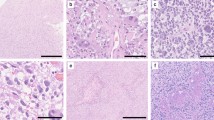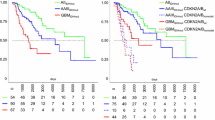Abstract
According to the recently updated World Health Organization (WHO) classification (2016), grade II–III astrocytomas are divided into IDH-wildtype and IDH-mutant groups, the latter being significantly less aggressive in terms of both progression-free and total survival. We identified a small cohort of WHO grade II–III astrocytomas that harbored the IDH1 R132H mutation, as confirmed by both immunohistochemistry and molecular sequence analysis, which nonetheless had unexpectedly rapid recurrence and subsequent progression to glioblastoma. Among these four cases, the mean time to recurrence as glioblastoma was only 16 months and the mean total survival among the three patients who have died during the follow-up was only 31 months. We hypothesized that these tumors had other, unfavorable genetic or epigenetic alterations that negated the favorable effect of the IDH mutation. We applied genome-wide profiling with a methylation array (Illumina Infinium Human Methylation 450k) to screen for genetic and epigenetic alterations in these tumors. As expected, the methylation profiles of all four tumors were found to match most closely with IDH-mutant astrocytomas. Compared with a control group of four indolent, age-similar WHO grade II–III astrocytomas, the tumors showed markedly increased levels of overall copy number changes, but no consistent specific genetic alterations were seen across all of the tumors. While most IDH-mutant WHO grade II–III astrocytomas are relatively indolent, a subset may rapidly recur and progress to glioblastoma. The precise underlying cause of the increased aggressiveness in these gliomas remains unknown, although it may be associated with increased genomic instability.



Similar content being viewed by others
References
Dolecek TA, Propp JM, Stroup NE, Kruchko C (2012) CBTRUS statistical report: primary brain and central nervous system tumors diagnosed in the United States in 2005–2009. Neuro Oncol 14(Suppl 5):v1–v49
Louis DN, Perry A, Reifenberger G, von Deimling A, Figarella-Branger D et al (2016) The 2016 World Health Organization classification of tumors of the central nervous system: a summary. Acta Neuropathol 131:803–820
Yan H, Parsons DW, Jin G, McLendon R, Rasheed BA et al (2009) IDH1 and IDH2 mutations in gliomas. N Engl J Med 360:765–773
Hartmann C, Meyer J, Balss J, Capper D, Mueller W et al (2009) Type and frequency of IDH1 and IDH2 mutations are related to astrocytic and oligodendroglial differentiation and age: a study of 1,010 diffuse gliomas. Acta Neuropathol 118:469–474
Watanabe T, Nobusawa S, Kleihues P, Ohgaki H (2009) IDH1 mutations are early events in the development of astrocytomas and oligodendrogliomas. Am J Pathol 174:1149–1153
Sanson M, Marie Y, Paris S, Idbaih A, Laffaire J et al (2009) Isocitrate dehydrogenase 1 codon 132 mutation is an important prognostic biomarker in gliomas. J Clin Oncol 27:4150–4154
Sturm D, Witt H, Hovestadt V, Khuong-Quang DA, Jones DT et al (2012) Hotspot mutations in H3F3A and IDH1 define distinct epigenetic and biological subgroups of glioblastoma. Cancer Cell 22:425–437
Wiestler B, Capper D, Sill M, Jones DT, Hovestadt V et al (2014) Integrated DNA methylation and copy-number profiling identify three clinically and biologically relevant groups of anaplastic glioma. Acta Neuropathol 128:561–571
Orillac C, Thomas C, Dastagirzada Y, Hidalgo ET, Golfinos JG et al (2016) Pilocytic astrocytoma and glioneuronal tumor with histone H3 K27M mutation. Acta Neuropathol Commun 4:84
Huse JT, Snuderl M, Jones DT, Brathwaite CD, Altman N et al (2017) Polymorphous low-grade neuroepithelial tumor of the young (PLNTY): an epileptogenic neoplasm with oligodendroglioma-like components, aberrant CD34 expression, and genetic alterations involving the MAP kinase pathway. Acta Neuropathol 133:417–429
Hatanpaa KJ, Hu T, Vemireddy V, Foong C, Raisanen JM et al (2014) High expression of the stem cell marker nestin is an adverse prognostic factor in WHO grade II–III astrocytomas and oligoastrocytomas. J Neurooncol 117:183–189
Snuderl M, Fazlollahi L, Le LP, Nitta M, Zhelyazkova BH et al (2011) Mosaic amplification of multiple receptor tyrosine kinase genes in glioblastoma. Cancer Cell 20:810–817
Takami H, Yoshida A, Fukushima S, Arita H, Matsushita Y et al (2015) Revisiting TP53 mutations and Immunohistochemistry—a comparative study in 157 diffuse gliomas. Brain Pathol 25:256–265
Bibikova M, Le J, Barnes B, Saedinia-Melnyk S, Zhou L et al (2009) Genome-wide DNA methylation profiling using Infinium® assay. Epigenomics 1:177–200
Baylin SB, Ohm JE (2006) Epigenetic gene silencing in cancer - a mechanism for early oncogenic pathway addiction? Nat Rev Cancer 6:107–116
Bibikova M, Barnes B, Tsan C, Ho V, Klotzle B et al (2011) High density DNA methylation array with single CpG site resolution. Genomics 98:288–295
Feinberg AP (2010) Epigenomics reveals a functional genome anatomy and a new approach to common disease. Nat Biotechnol 28:1049–1052
Feinberg AP (2010) Genome-scale approaches to the epigenetics of common human disease. Virchows Arch 456:13–21
Petronis A (2010) Epigenetics as a unifying principle in the aetiology of complex traits and diseases. Nature 465:721–727
Rakyan VK, Down TA, Balding DJ, Beck S (2011) Epigenome-wide association studies for common human diseases. Nat Rev Genet 12:529–541
Wakimoto H, Tanaka S, Curry WT, Loebel F, Zhao D et al (2014) Targetable signaling pathway mutations are associated with malignant phenotype in IDH-mutant gliomas. Clin Cancer Res 20:2898–2909
Finver SN, Nishikura K, Finger LR, Haluska FG, Finan J et al (1988) Sequence analysis of the MYC oncogene involved in the t(8;14)(q24;q11) chromosome translocation in a human leukemia T-cell line indicates that putative regulatory regions are not altered. Proc Natl Acad Sci USA 85:3052–3056
Nilsson JA, Cleveland JL (2003) Myc pathways provoking cell suicide and cancer. Oncogene 22:9007–9021
Sheiness D, Bister K, Moscovici C, Fanshier L, Gonda T et al (1980) Avian retroviruses that cause carcinoma and leukemia: identification of nucleotide sequences associated with pathogenicity. J Virol 33:962–968
Cotterman R, Knoepfler PS (2009) N-Myc regulates expression of pluripotency genes in neuroblastoma including lif, klf2, klf4, and lin28b. PLoS ONE 4:e5799
Cotterman R, Jin VX, Krig SR, Lemen JM, Wey A et al (2008) N-Myc regulates a widespread euchromatic program in the human genome partially independent of its role as a classical transcription factor. Cancer Res 68:9654–9662
Bai H, Harmanci AS, Erson-Omay EZ, Li J, Coskun S et al (2016) Integrated genomic characterization of IDH1-mutant glioma malignant progression. Nat Genet 48:59–66
Tateishi K, Iafrate AJ, Ho Q, Curry WT, Batchelor TT et al (2016) Myc-driven glycolysis is a therapeutic target in glioblastoma. Clin Cancer Res 22:4452–4465
Harris SL, Levine AJ (2005) The p53 pathway: positive and negative feedback loops. Oncogene 24:2899–2908
Haupt Y, Barak Y, Oren M (1996) Cell type-specific inhibition of p53-mediated apoptosis by mdm2. EMBO J 15:1596–1606
Haupt Y, Oren M (1996) p53-mediated apoptosis: mechanisms and regulation. Behring Inst Mitt 97:32–59
England B, Huang T, Karsy M (2013) Current understanding of the role and targeting of tumor suppressor p53 in glioblastoma multiforme. Tumour Biol 34:2063–2074
Biernat W, Kleihues P, Yonekawa Y, Ohgaki H (1997) Amplification and overexpression of MDM2 in primary (de novo) glioblastomas. J Neuropathol Exp Neurol 56:180–185
Ohgaki H, Kleihues P (2009) Genetic alterations and signaling pathways in the evolution of gliomas. Cancer Sci 100:2235–2241
Lukashchuk N, Vousden KH (2007) Ubiquitination and degradation of mutant p53. Mol Cell Biol 27:8284–8295
Leach FS, Tokino T, Meltzer P, Burrell M, Oliner JD et al (1993) p53 mutation and MDM2 amplification in human soft tissue sarcomas. Cancer Res 53:2231–2234
Momand J, Zambetti GP, Olson DC, George D, Levine AJ (1992) The mdm-2 oncogene product forms a complex with the p53 protein and inhibits p53-mediated transactivation. Cell 69:1237–1245
Oliner JD (1993) Discerning the function of p53 by examining its molecular interactions. Bioessays 15:703–707
Oliner JD, Pietenpol JA, Thiagalingam S, Gyuris J, Kinzler KW et al (1993) Oncoprotein MDM2 conceals the activation domain of tumour suppressor p53. Nature 362:857–860
Olson DC, Marechal V, Momand J, Chen J, Romocki C et al (1993) Identification and characterization of multiple mdm-2 proteins and mdm-2-p53 protein complexes. Oncogene 8:2353–2360
Rayburn E, Zhang R, He J, Wang H (2005) MDM2 and human malignancies: expression, clinical pathology, prognostic markers, and implications for chemotherapy. Curr Cancer Drug Targets 5:27–41
Costa B, Bendinelli S, Gabelloni P, Da Pozzo E, Daniele S et al (2013) Human glioblastoma multiforme: p53 reactivation by a novel MDM2 inhibitor. PLoS ONE 8:e72281
Shangary S, Wang S (2009) Small-molecule inhibitors of the MDM2-p53 protein-protein interaction to reactivate p53 function: a novel approach for cancer therapy. Annu Rev Pharmacol Toxicol 49:223–241
Vassilev LT, Vu BT, Graves B, Carvajal D, Podlaski F et al (2004) In vivo activation of the p53 pathway by small-molecule antagonists of MDM2. Science 303:844–848
Vu BT, Vassilev L (2011) Small-molecule inhibitors of the p53-MDM2 interaction. Curr Top Microbiol Immunol 348:151–172
Yu S, Qin D, Shangary S, Chen J, Wang G et al (2009) Potent and orally active small-molecule inhibitors of the MDM2-p53 interaction. J Med Chem 52:7970–7973
Nakamura M, Watanabe T, Klangby U, Asker C, Wiman K et al (2001) p14ARF deletion and methylation in genetic pathways to glioblastomas. Brain Pathol 11:159–168
Biernat W, Tohma Y, Yonekawa Y, Kleihues P, Ohgaki H (1997) Alterations of cell cycle regulatory genes in primary (de novo) and secondary glioblastomas. Acta Neuropathol 94:303–309
Acknowledgements
The authors would like to thank Niccole Williams and Agatha Villegas for administrative professional services. We also thank Ping Shang for some of the immunohistochemical stains. The authors would like to thank Stefan Pfister, David T. W. Jones, Martin Sill and Volker Hovestadt for their help with optimization of the 450 k Illumina Infinium methylation profiling for copy number analysis. A.A.H. was supported, in part, by a grant from the Department of Veteran’s Affairs (I01BX002559). The study was supported by the Friedberg Charitable Foundation grant to M.S. and M.A.K.
Author information
Authors and Affiliations
Corresponding author
Ethics declarations
Conflict of interest
The authors declare no conflict of interest.
Additional information
Timothy E. Richardson and Matija Snuderl have contributed equally to this work.
Electronic supplementary material
Below is the link to the electronic supplementary material.

11060_2017_2431_MOESM1_ESM.jpg
Supplemental Figure 1. Copy number analysis derived from the Illumina Infinium Human Methylation 450k array data, showing four conventional, indolent IDH-mutated astrocytomas with no subsequent progression. These four tumors show relatively little copy number changes across all chromosomes compared with the four tumors in our study group. (JPG 827 KB)
Rights and permissions
About this article
Cite this article
Richardson, T.E., Snuderl, M., Serrano, J. et al. Rapid progression to glioblastoma in a subset of IDH-mutated astrocytomas: a genome-wide analysis. J Neurooncol 133, 183–192 (2017). https://doi.org/10.1007/s11060-017-2431-y
Received:
Accepted:
Published:
Issue Date:
DOI: https://doi.org/10.1007/s11060-017-2431-y




